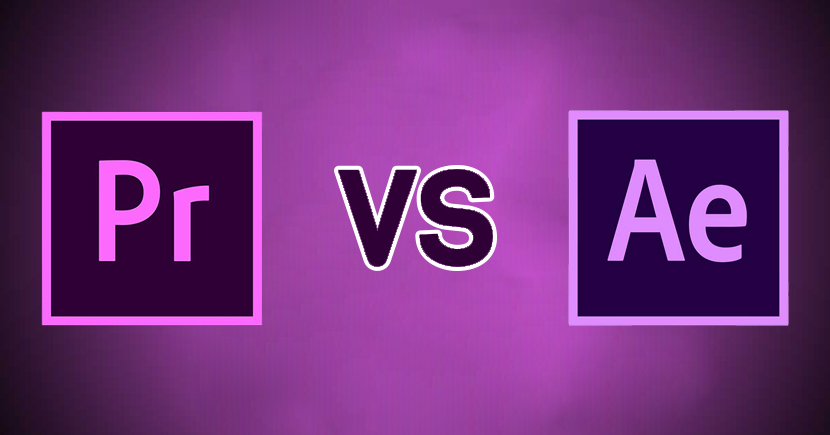Introduction
“What should I go with: After Effects vs Premiere Pro” – Anonymous
We can understand your confusion well because both Adobe Premiere Pro and Adobe After Effects are almost the same software. Still, there exist certain features and functions that will help you differentiate among them and better decide which one to go for!
The factors such as your requirements also come into play while deciding. Both the video editing software is optimize for the post-production processes such as cutting, editing, or splicing video clips or movies.
Nonetheless, each video editing program has pros and cons, which we will describe in detail below! So, let’s move to a detailed comparison guide on After Effects vs. Premiere Pro without any further ado. let’s understand what is the after effects. after that we will move on the difference between After Effects vs Premiere Pro
What is After Effects?
Image Source: No Film School
As mentioned earlier as well, After Effects is a video editing software that is used in the process of post-production tasks, generally after the video is composted.
As the name suggests, the primary goal of Adobe After Effects is to inculcate or create visual effects and motion graphics. Further, it can compost videos as well.
However, the program adds assets and layers, which you cannot do in Premiere Pro. Its motion tools are pretty much better than Premiere Pro and are mostly recommended to add motion to images, videos, and designs. Despite this, the extensive library of scripts, third-party plugins, and extensions also comes into play.
Adobe After Effects has a range of digital resources too to expand your knowledge base regarding the subjects through tutorials etc. And it is said to be a necessary program for creating visual effects or motion graphics for your projects.
After Effects vs Premiere Pro – What’s Different
After Effects vs Premiere Pro: both are different tools for video editing, with their own pros and cons. We’ll examine the differences and show you which one is best for your needs.
| After Effects | Premiere Pro |
|---|---|
| is a non-timeline-based editing software used in post-production processes to add visual effects or motion graphics to different clips. | This software is based on a timeline for composting videos. |
| It can create visual effects in videos or video games or add motion graphics, tracking, keying, and composition. | It creates and edits high-quality videos using RAW audio files, templates, templates, video files, and recordings. |
| The program is designed especially for VFX artists or designers to create specialized effects, including transitions and texts. | This program is built for linear-based video composition with different audio tracks. It also has the potential to color correct and process even high-resolution files. |
| It is used for video games, videos with special effects, and television tasks in post-production. | It is mainly used for videos, television production, and movie production. |
Key Features of After Effects
Without further ado, let’s look at some of the critical features of After Effects or an AE editing app 2022!
1 – MFR (Multi-frame rendering)
The recent launch of features among Adobe After Effects. However, this feature is for still images, where each frame will be a single image. Here, multiple processor cores are generally used to render video.
You can also use multi-frame rendering for exporting a video, and it improves the overall performance. You will experience more than 2X increment in performance even with a 4 to 8-core CPU in a modest system.
And this performance is even seen to be more than doubled in a system CPU with 16 or more cores.
2 – Universal text engine
Working with multiple or different languages is now a breeze with this new feature of After Effects. Now, you need only to begin typing in the selected language. There are direct settings in the Essential Graphics panel regarding the South Asian and Middle Eastern languages with the left-to-right or left-to-right settings.
It is possible to mix different scripts within the same graphics element, and each text layer is interchangeable, making graphics and titles easier and quicker for multilingual editing.
3 – Effects
The program contains a huge array of effects to add to your project. For instance, you can start with Content-Aware Fill as an impressive effect. It will remove distracting or unwanted items or objects in your video clips with just a click.
The effect will fill in the space surrounding it after you click around the object and completely erase the concerned item.
4 – Text animation
A list of unique fonts is available via the extensive Adobe Fonts database. You can choose to animate texts from here as well. Here, the text objects have special or unique parameters in addition to the general transformation properties. You can use text presets to make the animation even a breeze.
5 – Rotoscoping
You can isolate an object within this program using Rotoscoping feature. You can use specialized tools such as the Roto Brush to make the process even smoother and faster. The program automatically detects your subject using the AI technology of Adobe Sensei. You can then revert and clean the selection.
Different Use Cases of After Effects
How quickly you learn the subject will also depend upon how effectively you will be able to grasp the knowledge. So, The following scenario can make explicit use of After Effects
You can find a guide to choosing After Effects vs Premiere Pro on Adobe’s website. As mentioned, Adobe After Effects is a standard program for creating spectacular visual effects and motion graphics for your videos. However, after learning from two or three detailed tutorials, there’s no limit to what you can create with After Effects.
-
Visual effects
Image Source: InspirationTuts
After Effects contains an array of VFX or visual effects. These effects can be added by composting multiple images to make a unique shot or by using the rotoscoping feature to isolate objects. You can use it to add unique touches like 3D motion graphics within a scene.
So, you need to go for After Effects, whether you want to add an explosion in the battle scene, create a moving collage of videos and animation, or post-production lighting effects.
-
Animation
Image Source: RocketStock
After Effects is a well-renowned program for its motion graphics elements! Both animators and designers can use this program to create 2D or 3D animations with vectors and rasterized arts. There’s a facility to import photos or physical media into animations or generate motion graphics and titles.
-
Motion text and titles
Image Source: Motion Array
After Effects can easily create animated text layers or moving text features to create eye-opening credits sequences, 3D motion texts, lower third graphics, or kinetic typography videos.
Adobe After Effects price: Adobe After Effects has three pricing options ranging from $20.99 to $239.88.
What is Adobe Premiere Pro?
Image Source: Variety
As you know we have discuss the difference After Effects vs Premiere Pro. now let’s talk about Adobe Premiere Pro is another video editing application or software based on the timeline editor. The software allows you to compile videos, add effects, edit RAW videos, and export to any desired video format from a list of options.
Premiere Pro supports crisp video clarity and high-resolution graphics. This program also allows for audio mixing to help the video creators with narration, sound effects, or even background music.
It is also known as NLE or non-linear editor, which serves the primary goal of editing videos together in a sequence. Thus, it’s a scalable and robust editor for video creators and consists of essential elements like color correction tools, clip editor, audio programs, and even graphics tools.
Key Features of Adobe Premiere Pro
Let’s now dive into some of the top features or functions of Adobe Premiere Pro which differentiate it from After Effects!
1 – Transcription tools
Speech to Text is one of the recent features Premiere Pro launches. The program currently supports 14 different languages whose speech you can easily convert to text. It also gives you a series of fine-tuning options, such as choosing a particular language.
2 – Styling tools
Premiere Pro also has an array of styling tools when it comes to text. You can now play with more distinctive or unique text styles or add multiple shadows to your text layers. There’s an inbuilt spell checker, too, which applies to various languages.
You can add different scripts within the same graphic elements even better. It’s a commendable feature for multi-linguistic moviemakers.
3 – Motion graphics
It’s another latest update through which you can add motion graphics to videos. There’s a dedicated Graphics workspace within the program where you can select a motion graphic template and drop it right within the timeline.
Users can even make modifications here, such as changing the text, moving its position, changing its timing, etc.
4 – Color grading tools
Undoubtedly, Premiere Pro’s color grading couldn’t be better! Even though the Lumetri color grading tools of Premiere Pro are in direct competition with some other renowned color grading tools, it still has the potential to manage an editor’s daily requirements quite effectively.
The lumetri color correction panel of Premiere Pros is further straightforward enough for beginners. Premiere Pro is also ideal for look-up tables or LUTs, which act as filters and can be dropped directly over the videos.
5 – Multicam editing & Audio Editing and Mixing
It consists of some impeccable audio editing functions such as adding different kinds of audio within the Audio workspace or enabling automation modes within the track mixer. No matter how experienced you are with audio editing, you will find these features valuable.
However, beginners may find a hard time cracking their learning curve. There’s also a Multicam sequence feature within the program to handle editing of videos shot through multiple cameras, such as in interviews. Here, the content will be automatically timed and synced up properly.
Different Use Cases of Adobe Premiere Pro
The main aim of Adobe Premiere Pro is to sync well with the post-production workflow of a video editor. Post-production begins once you are done with the beginner photography sessions. Here is a screenshot from Adobe Premiere Pro showing the footage being edit.
-
Timeline editing
Image Source: Adobe Support
Using Adobe Premiere Pro, you can cut and arrange video files on a timeline, drag-and-drop them, etc. While professional Hollywood filmmakers and YouTubers Premiere Pro create top-notch content, it’s ideal for beginners too!
-
Audio editing
Image Source: No Film School
Premiere Pro can also be used for professional audio editing tasks. It can synchronize or edit the audio recorded on sets, it can reduce or boost sound levels, or the program can also be used to add sound or music effects to the audio.
-
Color-correction
Image Source: No Film School
Even though After Effects has a set of color-correction tools and functions, Adobe Premiere Pro is a beginner-friendly approach even for professionals for color grading, color-correction, or rendering tools like lookup tables (LUTs) and scopes.
Final Words
So, that’s all you need to consider about After Effects vs Premiere Pro! It’s better to learn the features of both programs before deciding to go with a particular one. Both programs have pros and cons and can be used simultaneously to perform different tasks.
For instance, you will not have the benefit of adding special effects to videos in Premiere Pro. This feature is available in After Effects; similarly, some of the other features are available in a specific program as a matter of their expertise.
Some Useful FAQs
Q. Is Adobe Premiere Pro Better Than After Effects?
We can’t say that one program is better than another one as it all boils down to your requirements and the scope of the learning curve you’re looking into. Let’s suppose the function of color correction is present in both the software, but Premiere Pro has a slightly narrow learning curve to learn this feature as compared to After Effects.
Q. After Effects vs. Premiere Pro: Which Is More Complicated?
In our opinion, After Effects has a broader learning curve than Premiere Pro, but you cannot have certain unique features in Premiere Pro, such as adding motion graphics, adding special effects to videos, etc.
Q. After Effects Mastery: How Long Does It Take
It will take a minimum of 8-9 weeks to learn After Effects from beginning to end. In addition, the answer depends on the speed with which you grasp the concept.













